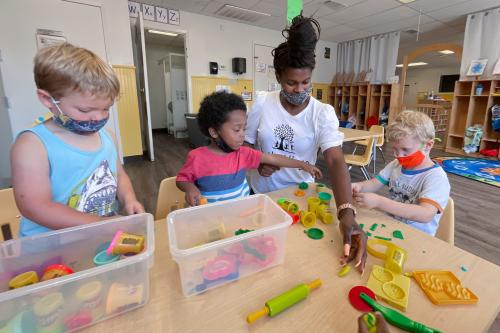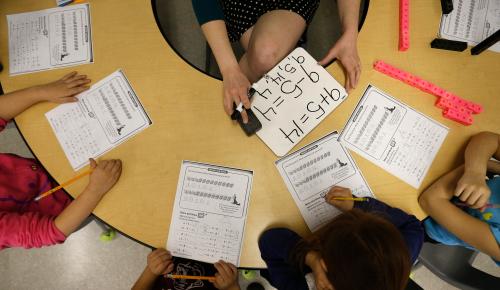Early last year, we published our book, “Teacher Diversity and Student Success,” through Harvard Education Press. Though it feels like eons ago, it was barely two years ago when we were putting finishing touches on the manuscript in the late spring of 2020. The COVID-19 pandemic had just recently shut down public schools, and the murder of George Floyd at the hands of police had triggered a wave of protests on racial justice. It wasn’t clear at that point how long or deep of an impact either of these developments would have on education in general, nor our book topic in particular.
Now, though, there’s enough distance from the book’s writing that an update feels warranted to recontextualize the book’s arguments against these tectonic shifts in society. Even more, during the past two years, we have seen a flowering of research on teacher diversity and student-teacher matching, and it’s worth providing an update on the book’s content, too. In this post, we reframe our book’s theses considering these new developments.
Our understanding of student-teacher race matching expands
First, let’s briefly recap the book’s argument: We have a long history of race-based educational achievement and attainment gaps in the U.S., which continue to persist despite many efforts to remediate them. We know teachers matter a great deal to student learning and future outcomes, though we have a longstanding disconnect between teacher diversity and a rapidly diversifying student body. Our primary thesis is that promoting more racial diversity among teachers and more inclusive work environments in schools will be good for everyone and disproportionately benefit students of color, helping to narrow these longstanding educational gaps.
New studies in this area published over the last two years have supported this thesis, strengthening the case for why teacher diversity matters now more than ever. The book discusses the evidence that having a same-race teacher improves test scores, a student’s likelihood of being selected for gifted and talented programs, graduating high school, and intending to enroll in college. More recent evidence adds a variety of other student benefits to this list: Increased exposure to same-race teachers is also associated with improvements in course grades, students’ attendance, students’ grit and interpersonal self-management, their working memory, and the likelihood of taking an advanced math course.
One persistent weakness of the research on race matching is that much (though not all) of the evidence comes exclusively from Black teachers matching with Black students. Fortunately, new studies have begun to fill in that hole in our understanding. One of us (Lindsay) was involved with a study using Texas data to document multiple benefits of exposure to Hispanic teachers on Hispanic students; that study found several short- and medium-term improvements in student outcomes. Similarly, Castro and Calzada explore the relationship between Latino teachers, bilingualism, and teaching practices. They find identity and bilingualism mutually reinforce instructional practices that are especially effective for Latino students. Also, evidence from New York City finds reductions in exclusionary discipline for race-matched students, with the reductions holding across distinct racial pairings: Black, Latino, and Asian Americans.
We should also note that novel studies suggest diversity beyond the classroom matters, too. Diverse school leadership is associated with a greater likelihood of employing diverse teachers (to students’ benefit overall). Also, diversity among professional staff including school counselors and administrators is associated with improved test scores and reductions in absences in Maryland schools.
Everyone benefits from teacher diversity, and everyone can be part of the solution
The book takes a full chapter to unpack how racial matching influences students in the classroom: namely, teachers’ differing expectations for students of diverse backgrounds, teachers as role models to impressionable students, and the use of culturally relevant pedagogy. Recent evidence adds important nuance here, showing that both stronger student-teacher relationships and more effective, tailored teaching practices are key mediators enabling the positive impacts teachers of color have on students of color. And interestingly, teacher experience appears to be a crucial factor narrowing teachers’ differing expectations of students by race over time.
Further, a remarkable new study from David Blazar uses randomized assignment for teachers in 4th and 5th grades to explore how teachers of color teach differently from white teachers. The randomized assignment design ensures that differences observed across classrooms are causal; and the usual standardized test scores are paired with rich data infrequently seen in education studies, including student socioemotional outcomes and teacher practices and beliefs.
Blazar finds teachers of color spend significantly more time preparing lessons and differentiating instruction for students. They were also more likely to hold growth mindset beliefs about students and spend more time developing relationships with students and families. If these differences sound like good teaching practices and beliefs overall, not those aimed specifically at helping students of color, you’re right. And this leads to one of the more notable findings from the study: Blazar finds white students’ test scores improve when taught by teachers of color, too.
Prior work has documented benefits for white students exposed to teachers of color, though these findings have been limited to changes in students’ attitudes and perspectives, not their test scores. This is the first study to show a positive impact on white students’ academics. Though a single positive study doesn’t upend the entire literature, it’s particularly encouraging that the benefits are linked to differences in teacher attitudes and practice, not simply the teachers’ racial differences.
This suggests broader adoption of these beliefs and practices helps all students, even as students of color disproportionately benefit. Moreover, these findings reinforce our book’s thesis that the appropriate policy prescription is not simply to diversify the teacher workforce—a critical, though insufficient step—but also relies on professional development to improve practices among existing, predominantly white teachers. This squares with other emerging research showing that training modules for teachers can have notable effects on teachers’ practices, helping to narrow gaps in key student outcomes by race.
Recontextualizing the need for teacher diversity
The world beyond our book’s main topic has meaningfully changed in the last two years, too. The biggest shift has been due to the COVID-19 pandemic and the consequent fallout for schools and students. Students of color were both more likely to attend schools that had extended periods of remote instruction and more likely to fall behind academically during the pandemic. Thus, the problem motivating the need for a diverse teacher workforce has grown more acute.
On an encouraging note, though, the pressing need for talent exacerbated by the pandemic may have helped loosen barriers to entry for teachers of color, thereby increasing teacher diversity (at least in Massachusetts). The higher-than-normal turnover among teachers could even be viewed as an opportunity for vanguard states and districts to make quick progress on teacher diversity—if they prioritize recruiting and supporting teachers of color.
The pandemic broke out amidst growing tensions between demands for a more comprehensive racial reconciliation in society and resistance to teaching or training that acknowledges racism playing a role in modern society. These culture war fights didn’t start in schools, but the classroom has emerged as a key battlefield for debates about the role of racism in America’s past and present. Thus, our call for policies promoting teacher diversity and inclusion in schools has taken on greater political significance since our writing and could be met with resistance in some areas.
We do not intend our book to be seen as a partisan statement. On the contrary, we see our work as helping to establish the empirical basis and the logical case for prioritizing teacher race as a policy lever—implicitly building a bridge between what we saw as disparate camps in education policy that often pitted teacher quality against teacher diversity.
Rather than being trade–offs, we argue that the benefits of diverse teachers and inclusive schools compare favorably against many popular education policies. Like class size reductions, for example, teacher diversity will have varied and durable benefits for students, but at a far lower expected cost. Teacher diversity will also promote a more equitable public education system overall.
Providing access to teacher diversity should be part of ongoing policy efforts to ensure universal access to teacher quality. Policymakers should prioritize diversity even as challenges around vacancies and shortages arise. Indeed, the current circumstances show the need among students is greater than ever, the window of opportunity to diversify the workforce is wider than ever, and the empirical basis for prioritizing diversity is stronger than ever.
-
Acknowledgements and disclosures
The authors thank Melissa Carmona for research assistance on this post.









Commentary
It matters now more than ever: What new developments say about Teacher Diversity and Student Success
August 1, 2022